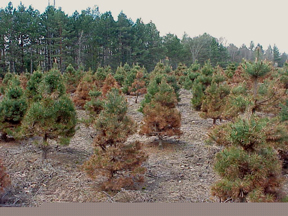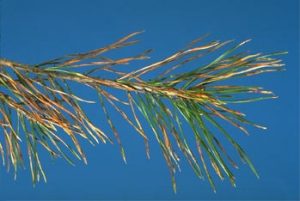The Fungus That Wants to Ruin Christmas
By Heather Walton, VCE Program Assistant

Lophodermium needlecast on Scotch pines
As we are all aware, evergreen trees are known for keeping their pines year-round, and do not go dormant in the winter. So, what does it mean when suddenly a conifer or cypress goes brown? A possible answer: fungus. There are several fungi pathogens that cause needle drop and even premature death for many varieties of evergreen. But the main culprit we’ll be focusing on, threatens our wonderful Christmas trees.
According to “Diseases of Trees and Shrubs” the fungus pathogen we need to watch out for is Lophodermium seditiosum Needle Casts (Sinclair, et al.). This fungus affects Christmas tree plantations- especially if that plantation contains Scotch, Austrian, or Red pines- and can cause the most damage.
 As a fungus, it travels through spores, and typically contaminates the tree by infecting wet needles of branches at least a year old. It then colonizes within the needles, and causes premature senescence and casting. This basically means that the spores irreversibly stunt or arrest the growth of the needles and branches of the tree.
As a fungus, it travels through spores, and typically contaminates the tree by infecting wet needles of branches at least a year old. It then colonizes within the needles, and causes premature senescence and casting. This basically means that the spores irreversibly stunt or arrest the growth of the needles and branches of the tree.
So how do we know if this is what ails our trees? And most importantly, how do we treat them? According to Penn State Extension, “The most accurate and easiest identification period for Lophodermium needle cast is in mid- to late summer when the fruiting bodies are present on needles infected the previous year. The shiny, black, football-shaped fruiting bodies are 1⁄32 inch (0.8 mm) long. They are slightly raised and aligned lengthwise on the needle. When mature, they have a longitudinal slit through which spores will be released,” they also recommend taking the infected needle in a paper towel for twenty minutes to see if it releases spores.
Once you have indicated that it is indeed Lophodermium seditiosum the best thing to do is to take out the tree completely, and rake up any infected needles around that area. After that, it’s all about prevention. Keep your trees in areas where they will remain as dry as possible (but not so dry they die of thirst), and make sure they are not down wind of any other infected conifers. Other methods, such as making sure the area under the tree is clear of weeds, or even applying fungicide three or four times in the summer if it gets really bad is recommended.
Now, if your pine tree is turning brown, don’t immediately assume the fungus. There are many other culprits too, such as bugs, adverse weather, or even animal damage (“Pocket Guide to Christmas Tree Diseases”). If you do suspect it is a fungus, be sure to bring a sample to your nearest plant clinic, and they can help ease your worries, or confirm your suspicion. So, while we ring in 2018, and make room for our living room furniture again, let us also check on our conifers, and make sure they stay evergreens.
References
• Lophodermium Needle Cast, Penn State Extension, 2017
• Pocket Guide to Christmas Tree Diseases, U.S. Department of Agriculture Forest Service, Northern
Research Station
• Diseases of Trees and Shrubs, Sinclair, Wayne, Lyon, Howard, and Johnson, Warren, Cornell
University Press
• Stress-Induced Premature Senescence Or Stress-Induced Senescence-Like Phenotype: One In Vivo Reality,
Two Possible Definitions?, US National Library of Medicine, National Institutes of Health
• This is The Season to Protect Against Lophodermium Needlecast, Michigan State University Extension